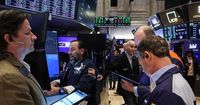U.S. stock markets faced a tumultuous week as uncertainty surrounding President Donald Trump’s trade policies continued to weigh heavily on investor sentiment. On April 14, 2025, stocks whipsawed as the tariff war with major trade partners showed little signs of abating, leaving investors hesitant to take on significant risk after a brief rally. The S&P 500, which had climbed nearly 1% earlier in the day, ultimately finished lower, highlighting the ongoing volatility in the market.
United Airlines Holdings Inc. maintained its full-year profit outlook but warned that a potential recession could severely impact demand and earnings. This cautionary note from the airline came amid a broader context of economic uncertainty, as investors braced for more turbulence in the coming weeks.
The following day, on April 15, 2025, U.S. stock futures slipped further as investors anticipated the release of a crucial retail sales report and awaited additional earnings from the first-quarter season. Dow Jones Industrial Average futures dropped 139 points, or 0.3%, while S&P 500 futures and Nasdaq 100 futures dipped 0.7% and 1.1%, respectively. Shares of Nvidia plummeted more than 6% after the company announced it would incur a $5.5 billion quarterly charge related to exporting its H20 graphics processing units to China and other nations.
This downward trend followed a relatively muted trading session on Tuesday, where the three major averages closed in the red after back-to-back winning sessions. The Dow shed nearly 156 points, or 0.4%, while the S&P 500 slipped 0.2%. The Nasdaq Composite also ended the day marginally lower, reflecting the cautious mood among investors.
Since President Trump announced his tariffs on April 2, 2025, both the Dow and the Nasdaq have experienced declines of approximately 4.4%, while the S&P 500 has dropped about 4.8%. Allianz's chief economic advisor, Mohamed El-Erian, emphasized the ongoing uncertainty, stating, "Fundamentally, things have not been resolved. The game of chicken between China and the U.S. continues, and other countries are trying to figure out how to navigate this." He cautioned that while the current calmness in the market is welcome, it should not be taken for granted, predicting volatility ahead.
Investors were particularly focused on the upcoming retail sales report for March, with economists polled by Dow Jones expecting a 1.2% increase from the previous month, up from a meager 0.2% climb in February. This data arrives at a time when consumer confidence is shaky, with concerns about inflation and the broader economy looming large. Additionally, industrial and manufacturing production data is set to be released, further influencing market sentiment.
As the earnings season progresses, several major companies, including Travelers, U.S. Bancorp, Abbott Labs, ASML, and Citizens Financial, are scheduled to report their results. However, the specter of trade policy changes continues to muddy the outlook, with many executives reluctant to provide earnings guidance amidst the uncertainty.
On the same day, U.S. stocks ended slightly lower, with the Dow down 0.4%, the S&P 500 down 0.2%, and the Nasdaq down 0.1%. The uncertainty surrounding tariffs remained a significant concern for investors. Boeing's stock, for instance, fell 2.4% after reports indicated that China had ordered its airlines not to take further deliveries of Boeing jets in response to the U.S. decision to impose 145% tariffs on Chinese goods. This escalation in trade tensions has raised alarms about a potential global trade war and its implications for the economy.
Moreover, the Trump administration is moving forward with investigations into imports of pharmaceuticals and semiconductors, which could lead to further tariffs on these sectors. Analysts are particularly concerned about the impact of these developments on consumer spending, as bank executives have warned that prolonged trade disruptions could pose significant risks to the U.S. economy.
Despite the overall market downturn, some sectors showed resilience. Bank of America reported better-than-expected first-quarter profits, driven by increased interest income, causing its shares to rise by 3.6%. However, Johnson & Johnson's shares ended down 0.5% after the company missed estimates for sales of medical devices, despite beating Wall Street expectations for overall revenue and profit.
As the market continues to grapple with these challenges, strategists are closely monitoring technical indicators. The S&P 500's 50-day moving average recently slipped below the 200-day moving average, resulting in a "death cross" pattern that suggests a potential longer-term downtrend. Currently, the S&P 500 remains down 12.2% from its record-high close on February 19, 2025, and approximately 8% for the year to date.
In a related development, a 17% tariff on Israel by the U.S. appears to be on hold for the moment. However, concerns linger about the indirect impacts of such tariffs, particularly regarding a potential recession in Israel’s small market. The instability and uncertainty resulting from these trade policies have prompted over 8,000 tech workers to relocate from Tel Aviv, which has subsequently been downgraded in the global ranking of the top 50 wealthiest cities.
As the situation continues to evolve, market participants remain on high alert, ready to react to any shifts in trade policy and economic indicators that may emerge in the coming days. With earnings reports and economic data set to be released, all eyes will be on how these factors influence market sentiment and investor behavior moving forward.






